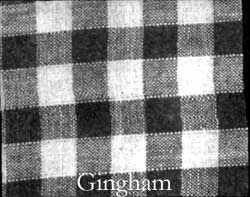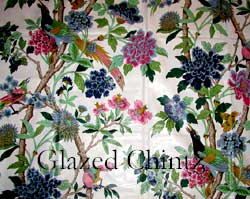TEXTILE DICTIONARY AND TERMS RELATING TO TEXTILE
G
Gabardine or gaberdine. Name of Jewish mantle or cloak of the Middle Ages. Modern twilled fabric. I. Soft mercerized cotton gaberdine. Shows raised cord on right side, White and colors. Uses: suits, skirts, vestings. Weave twill. Width, 36". 2. Firm, worsted material, same as cotton gabardine. May have smooth, hard surface or soft dull one. Piece-dyed. Uses: dresses, suits, uniforms, riding habits. Weave—twill. Width, 54".
Galatea. Strong, firm, heavy cotton fabric. White, dyed in plain colors or printed. Durable, but usually fades. Uses: children's play clothes, middies, skirts. Weave— satin. Width, 27".It was named after the man- of-war H.M.S. Galatea, and the fabric was at one time in demand for use in making children's sailor suits.
Gassing. Protruding fibres on cotton yarns or cloth are singed over gas flames, making a smooth surface.
Gathers: Gathering can be done, by hand, by machine, automatically, with elastic and through channels. Gathering by hand and machine involves stitching across the edge of the fabric and pulling on the loose thread to draw up the fabric into mini-folds. The density of the mini-folds, in combination with the stitch length determines the fullness.
Gauge. Applies to closeness of meshes or wales which determine the fineness of a knitted fabric.
Gauze.
1. Former name for a kind of weave now called "leno" in which the warp yarns instead of lying parallel are arranged in pairs which twist between the filling yarns making an open lacy effect as in marquisette.
2. Thin curtain fabrics in plain or leno weave often called gauze.
3. Cheese cloth of all kinds called gauze in the trade. Customers know the names, surgeon's gauze and hospital gauze.
Georgette.
Thin, silk fabric, dull in texture with cr&py effect due to tightly twisted yarns in both warp and filling. Right and left hand twist alternate. Woven in the gum, degummed before dyeing. Launders. Piece-dyed or printed. Uses: blouses, gowns, trimming, millinery. Weave— plain. Width, 40".
Gigging. Operation of raising nap on woolens.

Gingham. Yarn-dyed fabric woven in checks, plaids or stripes, or may be plain color. Washes well and usually holds dye. Thin, coarse ginghams tend to shrink. Uses: dresses, shirts, aprons, children's clothes. Weave—plain or fancy. Width, 26" to 40". Name of Indonesian origin, imported in Europe by Dutch, produced in Manchester (England) from the second half of the 18th century.
1. Apron checks. Coarse, stiff, checked fabric. Any color with white. Use: aprons. Width, 26", 27".
2. Chambray. Plain colored gingham, often having white filling. Width, 27", 32".
3. French. See Zephyr.
4. Nurses' or Red Cross gingham. Heavy blue and white striped, closely woven. Uses: nurses' uniforms, house dresses. Width, 32".
5. Scotch ginghams are those made in Scotland. Fine quality, beautiful colors and plaids.
6. Tissues are thinner than ordinary ginghams. Often have heavy cord in stripe or check or embroidered design. St. Gall tissues from Switzerland are famous for their beauty.
7. Zephyr ginghams and French ginghams used for dresses. Fine, light weight, soft finished, attractive coloring and designs. Made in America.
The following are trade named fabrics related to ginghams. Heavier and closer than gingham. Devonshire, Kiddie Kloth* Surf cloth, Kindergarten cloth* Romper cloth* Uses: children's clothes, dresses. Weave—plain. Width, 32".
Glad (Fr. pr. glah-say). Glistening, smooth, resembling ice. Applies to some two-toned silks. Warp and filling of different colors. Also applies to a special finish.
Glass toweling. Plain, smooth fabric having stripes or checks of blue or red on a white ground. Linen glass toweling does not become linty. Name indicates purpose, wiping glassware. Used for all dishes. A loose weave allows greater absorption, but does not wear so well. Colored stripes, mercerized cotton, should be fast to washing. May be all linen, union, or cotton. Weave—plain. Width, 15", 16", 17", 18".
Glazed chintz. Both chintz and plain color fabrics are treated with paraffin and calendered. Used for curtains, lampshades, slip covers and upholstery. Better qualities may be washed like oilcloth

.
Gloria. Originally an umbrella fabric having silk warp and worsted filling. Cotton weft fabric of same type called gloria.
Glossing. Stretching and moistening silk yarns to impart lustre.
Glove silk. Knit fabric originally used for gloves; now for undergarments, gloves and cut hose. See Milanese, Tricot, Warp knit, and Italian silk.*
Gobelins. Royal tapestry works in Paris. Machine woven tapestry sometimes incorrectly called Gobelin.
Golf cloth. Fine woolen material well milled and finished smooth. In plain colors, preferably red or green. Used for sports wear.
Granite Cloth. Hard finished, pebbly cloth. Its roughness suggests the surface of granite. Worsted yarns. Piece-dyed. Excellent for hard wear. See Mummy cloth. Use: dresses. Weave—fancy. Width, 42", 50", 54".
Grass bleaching. Exposing cloth to air, light and moisture by spreading on grass. Slower than chemical bleaching but does not weaken fabric. Method used extensively in Ireland and Scotland. Called "grassing" or "crofting".
Grass cloth. See Canton linen.
Grass rug. There are many rugs on the market woven of native grass and cotton warp. Crex is a well known trade name. Plain natural color or printed. By the yard or in standard size rugs.
Grenadine. Related to marquisette. Both made with leno (gauze) weave. Sometimes two warp yarns are twisted about one filling yarn or two warp yarns are twisted between two filling yarns also twisted about each other,
1. Usually silk or wool for dress goods.
2. Cotton curtain fabric of leno construction with swivel dots or figures in white or color. Resembles curtain madras.
Gros de Londres (Fr. pr. gro-de-londr). Cross-ribbed dress silk with heavy and fine ribs alternating or ribs of different colors. Texture resembles taffeta. Use: dresses. Weave —plain. Width, 40".
Grosgrain (pr. gro-gran, French, coarse grain). Firm, stiff, closely woven, corded fabric. Ribs vary from 50 to 70 per inch. Filling may be of cotton, but usually weighted silk. Cords are heavier and closer than those in poplin, more round than those in faille. Wears well if not too heavily weighted. Uses: dresses, ribbons, coats. Weave—plain (corded). Width, 27", 36".
